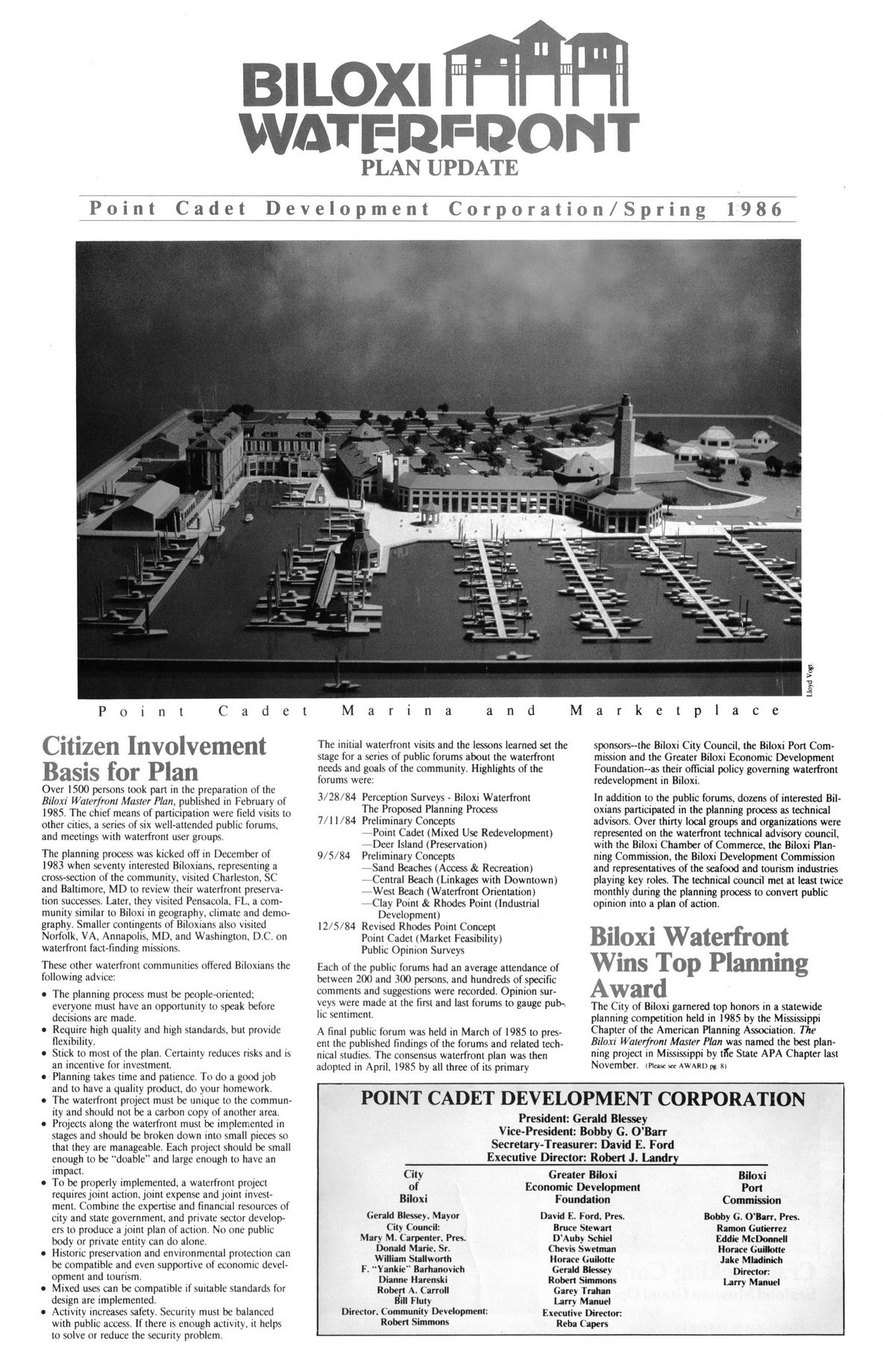This text was obtained via automated optical character recognition.
It has not been edited and may therefore contain several errors.
BILOXI ffifftH VVATFRFDONT PLAN UPDATE Point Cadet Development C o r p o r a t i o n / S p r i n g 1986 Citizen Involvement Basis for Plan Over 1500 persons took part in the preparation of the Biloxi Waterfront Master Plan, published in February of 1985. The chief means of participation were field visits to other cities, a series of six well-attended public forums, and meetings with waterfront user groups. The planning process was kicked off in December of 1983 when seventy interested Biloxians, representing a cross-section of the community, visited Charleston, SC and Baltimore, MD to review their waterfront preservation successes. Later, they visited Pensacola, FL, a community similar to Biloxi in geography, climate and demography. Smaller contingents of Biloxians also visited Norfolk, VA, Annapolis, MD, and Washington, D.C. on waterfront fact-finding missions. These other waterfront communities offered Biloxians the following advice: • The planning process must be people-oriented; everyone must have an opportunity to speak before decisions are made. • Require high quality and high standards, but provide flexibility. • Stick to most of the plan. Certainly reduces risks and is an incentive for investment. • Planning takes time and patience. To do a good job and to have a quality product, do your homework. • The waterfront project must be unique to the community and should not be a carbon copy of another area. • Projects along the waterfront must be implemented in stages and should be broken down into small pieces so that they are manageable. Each project should be small enough to be “doable” and large enough to have an impact. • To be properly implemented, a waterfront project requires joint action, joint expense and joint investment. Combine the expertise and Financial resources of city and state government, and private sector developers to produce a joint plan of action. No one public body or private entity can do alone. • Historic preservation and environmental protection can be compatible and even supportive of economic development and tourism. • Mixed uses can be compatible if suitable standards for design are implemented. • Activity increases safety. Security must be balanced with public access. If there is enough activity, it helps to solve or reduce the security problem. The initial waterfront visits and the lessons learned set the stage for a series of public forums about the waterfront needs and goals of the community. Highlights of the forums were: 3/28/84 Perception Surveys - Biloxi Waterfront The Proposed Planning Process 7/11/84 Preliminary Concepts —Point Cadet (Mixed Use Redevelopment) —Deer Island (Preservation) 9/5/84 Preliminary Concepts —Sand Beaches (Access & Recreation) —Central Beach (Linkages with Downtown) —West Beach (Waterfront Orientation) —Clay Point & Rhodes Point (Industrial Development) 12/5/84 Revised Rhodes Point Concept Point Cadet (Market Feasibility) Public Opinion Surveys Each of the public forums had an average attendance of between 200 and 300 persons, and hundreds of specific comments and suggestions were recorded. Opinion surveys were made at the first and last forums to gauge pub-, lie sentiment. A final public forum was held in March of 1985 to present the published findings of the forums and related technical studies. The consensus waterfront plan was then adopted in April, 1985 by all three of its primary sponsors--the Biloxi City Council, the Biloxi Port Commission and the Greater Biloxi Economic Development Foundation-as their official policy governing waterfront redevelopment in Biloxi. In addition to the public forums, dozens of interested Biloxians participated in the planning process as technical advisors. Over thirty local groups and organizations were represented on the waterfront technical advisory council, with the Biloxi Chamber of Commerce, the Biloxi Planning Commission, the Biloxi Development Commission and representatives of the seafood and tourism industries playing key roles. The technical council met at least twice monthly during the planning process to convert public opinion into a plan of action. Biloxi Waterfront Wins Top Planning Award The City of Biloxi garnered top honors in a statewide planning competition held in 1985 by the Mississippi Chapter of the American Planning Association. The Biloxi Waterfront Master Plan was named the best planning project in Mississippi by tffe State APA Chapter last November. iPieascscc award p* si POINT CADET DEVELOPMENT CORPORATION President: Gerald Blessey Vice-President: Bobby G. O’Barr Secretary-Treasurer: David E. Ford Executive Director: Robert J. Landry City Greater Biloxi Biloxi of Economic Development Port Biloxi Foundation Commission Gerald Blessey. Mayor David E. Ford, Pres. Bobby G. O'Barr, Pres. City Council: Bruce Stewart Ramon Gutierrez Mary M. Carpenter, Pres. D'Auby Schiel Eddie McDonnell Donald Marie. Sr. Chevis Swetman Horace GuiHotte William Stallworth Horace Guilotte Jake Mladinich F. "Yankie" Barhanovich Gerald Blessey Director: Dianne Harenski Robert Simmons Larry Manuel Robert A. Carroll Bill Fluty Director, Community Development Robert Simmons Garey Trahan Larrv Manuel Executive Director: Reba Capers

Biloxi Document-(002)